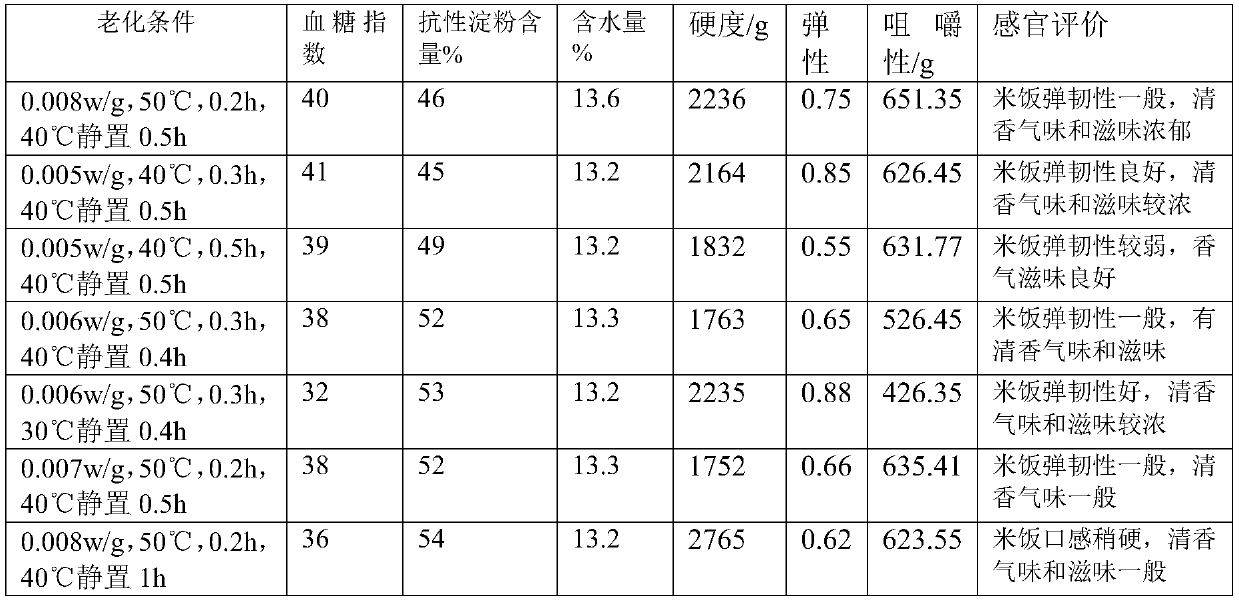A kind of low glycemic index cereal rice and production method thereof
A technology of low glycemic index and glycemic index, applied in the field of low glycemic index grain rice and its production, can solve problems such as lowering glycemic index, and achieve the effects of lowering glycemic index, improving digestibility and reducing bacteria.
- Summary
- Abstract
- Description
- Claims
- Application Information
AI Technical Summary
Problems solved by technology
Method used
Image
Examples
Embodiment 1
[0033] A kind of grain rice with low glycemic index, the grain is indica rice
[0034] Process:
[0035] 1) Soak the grain in water, soak in 3 times the water at 30°C for 22 hours, use 500W / kg ultrasonic treatment for 3 minutes during the soaking process, stop the ultrasonic wave for 20 minutes, repeat the action until the soaking is completed, and drain to obtain material 1;
[0036] 2) Add material 1 to cooking liquid (drinking water) for aging (pressure cooker, water isolation, cooking at 120°C for 30 minutes, rinsing with cold water, standing at 40°C and relative humidity of 80% for 20h), and filtering out the cleaning wastewater to obtain Material 2;
[0037] 3) Aging treatment of material 2 (0.008w / g dose of microwave, 50°C, treatment for 0.2h, breaking up the material, standing at 40°C for 0.5h, repeated twice), to obtain material 3;
[0038] 4) Dry the material 3 (0.08w / g microwave dosage, treat for 20min, then dry with hot air at room temperature until the water con...
Embodiment 2
[0041] Example 2: Effect of Aging Conditions on Low Glycemic Index Cereal Rice
[0042] Same as Example 1, but step 3) aging conditions change microwave dosage, temperature, time, standing conditions are respectively adopted as shown in Table 2, and the results are shown in Table 1.
[0043] Table 1 Effect of aging conditions on low glycemic index cereal rice
[0044]
[0045]
[0046] It can be seen from Table 1 that the aging treatment can reduce the glycemic index of cereal rice and increase the content of resistant starch. By combining different conditions, cereal rice with low glycemic index and high content of resistant starch can be obtained, and the corresponding taste of rice can satisfy people’s taste Grain rice with low glycemic index, high resistant starch content, and good sensory quality can be obtained by using appropriate conditional aging conditions (0.006w / g, 50°C, 0.3h, 30°C for 0.4h).
Embodiment 3
[0047] Example 3 Effect of aging times on low glycemic index cereal rice
[0048] Same as Example 1, but step 3) aging is repeated 1, 3, 4, 5 times, see Table 2.
[0049] Table 2 Effect of aging times on low glycemic index cereal rice
[0050] Aging times glycemic index Resistant starch content, % Moisture content, % 1 56 38 13.2 2 42 46 13.6 3 40 49 13.2 4 38 52 13.3 5 33 53 13.6
[0051] It can be seen from Table 2 that the aging treatment can reduce the glycemic index of grain rice and increase the content of resistant starch. With the increase of aging times, the glycemic index decreases and the content of resistant starch increases.
PUM
 Login to View More
Login to View More Abstract
Description
Claims
Application Information
 Login to View More
Login to View More - R&D
- Intellectual Property
- Life Sciences
- Materials
- Tech Scout
- Unparalleled Data Quality
- Higher Quality Content
- 60% Fewer Hallucinations
Browse by: Latest US Patents, China's latest patents, Technical Efficacy Thesaurus, Application Domain, Technology Topic, Popular Technical Reports.
© 2025 PatSnap. All rights reserved.Legal|Privacy policy|Modern Slavery Act Transparency Statement|Sitemap|About US| Contact US: help@patsnap.com



